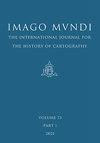在一个圆圈里——赫里福德地图是一个“宇宙时钟”
IF 0.5
4区 历史学
Q4 GEOGRAPHY
Imago Mundi-The International Journal for the History of Cartography
Pub Date : 2023-08-18
DOI:10.1080/03085694.2023.2225986
引用次数: 0
摘要
本文章由计算机程序翻译,如有差异,请以英文原文为准。
In a Circle—The Hereford Map as a ‘Cosmic Clock’
ABSTRACT This article presents an alternative approach to reading the temporal layer of medieval mappaemundi by comparing its shape to that of a sundial rather than superimposing a vertical chronological axis on the map. The possible uses of introducing such an analogy are discussed with regard to the late thirteenth-century Hereford world map. While this article does not seek to override established findings, it argues that adding this new interpretation to the existing research could potentially enrich our understanding of the ties between time and space in medieval cartography.
求助全文
通过发布文献求助,成功后即可免费获取论文全文。
去求助
来源期刊
CiteScore
0.20
自引率
0.00%
发文量
32
期刊介绍:
The English-language, fully-refereed, journal Imago Mundi was founded in 1935 and is the only international, interdisciplinary and scholarly journal solely devoted to the study of early maps in all their aspects. Full-length articles, with abstracts in English, French, German and Spanish, deal with the history and interpretation of non-current maps and mapmaking in any part of the world. Shorter articles communicate significant new findings or new opinions. All articles are fully illustrated. Each volume also contains three reference sections that together provide an up-to-date summary of current developments and make Imago Mundi a vital journal of record as well as information and debate: Book Reviews; an extensive and authoritative Bibliography.

 求助内容:
求助内容: 应助结果提醒方式:
应助结果提醒方式:


